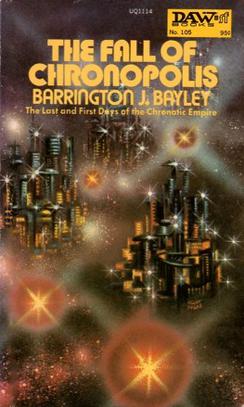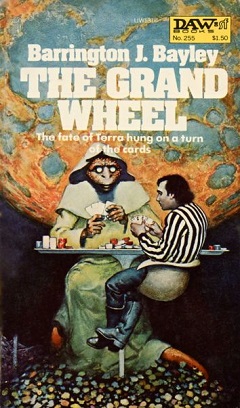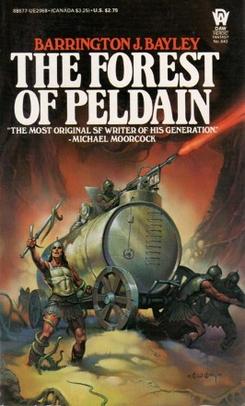
Ground Zero Man is a science fiction novel by British writer Bob Shaw, first published in 1971, and then revised as The Peace Machine in 1985.
Barrington J. Bayley was an English science fiction writer.
Ghastly Beyond Belief is a book by Neil Gaiman and Kim Newman published in 1985.

Collision Course is the fourth novel by the science fiction author Barrington J. Bayley. The novel was inspired by the multiple time dimensions proposed by J. W. Dunne. The plot centers on the collision of two alternate "presents", with disastrous implications for reality.

The Fall of Chronopolis (ISBN 0-87997-043-X) is the fifth novel by the science fiction author Barrington J. Bayley. It details the eternal conflict through time between the Chronostatic Empire and its enemy, the Hegemony.

The Grand Wheel is the eighth science fiction novel by Barrington J. Bayley. The novel follows Cheyne Scarne, a professor of "randomatics", as he is selected by the eponymous organization to represent humanity in a card game with infinitely varying rules. The name of the main character appears to be a reference to John Scarne.

Annihilation Factor is the second science fiction novel by Barrington J. Bayley, expanded from a 1964 short story originally published in New Worlds. It centres on the strains placed on a galactic empire by the appearance of the mysterious, planet-devouring "patch".

Star Winds is the ninth science fiction novel by Barrington J. Bayley. In the future Solar System of the novel, humans travel through space using solar sails and, as with much of Bayley's work, alchemy and other pseudosciences play a role alongside more conventional technology.

The Rod of Light is the thirteenth science fiction novel by Barrington J. Bayley and his only sequel.

The Forest of Peldain is the twelfth science fiction novel by Barrington J. Bayley. Set on the water world of the Hundred Islands, the Arelian empire attempts to seize control of the last island, Peldain, which within its dense forests contains an independent kingdom and an ancient secret.

The Knights of the Limits is the first science fiction collection by Barrington J. Bayley. The book collects nine short stories published between 1965 and 1978, one of which is original to this volume.
A Rose for Armageddon is a novel by Hilbert Schenck published in 1982.
The Hamlyn Book of Horror and S.F. Movie Lists is a book written by Roy Pickard and published in 1983.
Empire of the East is a novel by Fred Saberhagen published in 1979.
Darkchild is a novel by Sydney J. Van Scyoc published in 1982.
Against Infinity is a novel by Gregory Benford published in 1983.

The Castle of Dark is a novel by Tanith Lee published in 1978.
Raven of Destiny is a novel by Peter Tremayne published in 1984.
The Warrior Who Carried Life is a novel by Geoff Ryman published in 1985.
Damiano is a fantasy novel by R. A. MacAvoy published in 1984.










